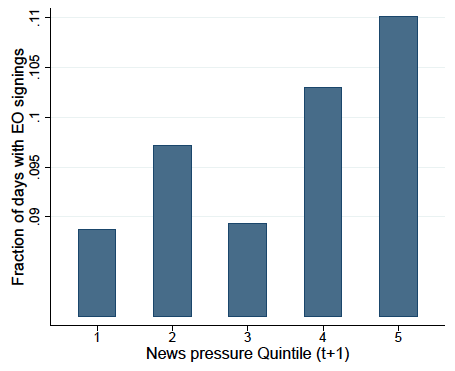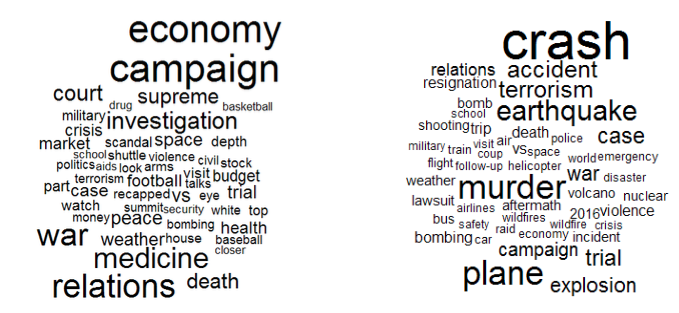Do politicians exploit the news cycle to “hide” actions they would rather remain unnoticed? In “Media Attention and Strategic Timing in Politics: Evidence from U.S. Presidential Executive Orders” (BSE Working Paper 1125), Milena Djourelova and Ruben Durante investigate the timing of executive orders (EOs) issued by United States presidents and find evidence consistent with such strategic behavior. EOs, and specifically ones that are likely to generate negative publicity, tend to be issued on the eve of days when other important events distract the media and the public.
Burying bad news
On August 25, 2017, one day before Hurricane Harvey’s strike in Texas, President Trump pardoned a former sheriff accused of racial profiling and issued a ban against transgender soldiers in the military. On June 14, 2018, the day of the inauguration of the 2018 FIFA World Cup in Russia, the country’s government announced a rise in the retirement age and an increase in the value added tax. On July 13, 1994, the Italian government of Silvio Berlusconi passed an emergency decree that freed hundreds of politicians with pending corruption charges – on the day Italy qualified for the final of the FIFA World Cup.
Such coincidences raise a natural suspicion: could they be due to a calculated political strategy, rather than chance? Previous research, as well as casual observation of the media cycle suggest that the availability of top stories that occupy the attention of the media can significantly reduce the time and resources available for the coverage of other news. So, timing a controversial announcement to coincide with anticipated top news stories may be an effective way to avoid media scrutiny.
Djourelova and Durante test this hypothesis by studying the timing of executive orders (EOs) issued by US presidents over the past 40 years. Presidential EOs provide an ideal setting to study strategic behavior. First, the White House has full discretion over their timing and content. Second, since EOs can be used by the president to push an agenda that circumvents Congress, they can also generate controversy — especially when the Congressional majority is ideologically opposed to the president.
The authors collect data on the text and date of signing of each EO, as well as transcripts of all news stories featured in the evening newscasts of the major U.S. broadcast TV networks. Thus, their analysis combines comprehensive information on EOs and on the coverage devoted to other top newsworthy stories each day.
Evidence of strategic timing
The main finding of the paper is that EOs are disproportionately likely to be signed on the eve of days when the news cycle is dominated by other events. This can be seen in Figure 1, which reports the frequency of EOs against next-day news pressure – a measure of the time devoted to the top stories unrelated to EOs or their content. Importantly, this finding applies only to periods of divided government – when the president and Congress belong to opposite parties. Indeed, in these times, unilateral presidential action is more likely to attract criticism due to the presence of a hostile Congress.


If this correlation is due to an intentional forward-looking strategy, it should be caused by EOs coinciding with anticipated news stories that the White House could have planned around (e.g. political or sports events). On the other hand, coincidences with surprising stories (e.g. earthquakes or terror attacks) are more plausibly due to chance. To identify the two types of stories, the authors apply text analysis techniques to the content of each news segment and distinguish between news containing more words associated with anticipation, and those containing more words associated with surprise. Figure 2 depicts the most frequent words in the headlines of the “surprise” and “anticipation” news segments respectively. This allows the authors to test separately for a relationship between EOs and the “anticipation” vs “surprise” component of news pressure. They show that the positive relationship between the timing of EOs and news pressure indeed holds only for news associated with anticipation, while there is no correlation with surprising news.

The paper also shows several compelling pieces of evidence that helps better understand the mechanisms behind the finding. First, the volume of news coverage of EOs is associated with a decline in presidential approval ratings (as measured in Gallup’s daily polls), but only when the government is divided. This suggests that when the public is informed, it is likely to react negatively to the use of EOs to circumvent Congress opposition. Second, the types of EOs that drive the relationship with news pressure are ones that plausibly carry a stronger incentive to ‘conceal’. This is the case for (1) EOs that are ex-ante more likely to make the news – proxied by the fact that they appeared in the Associated Press news wire, and (2) EOs that are ex-ante more likely to attract criticism for over-stepping presidential authority – i.e. on topics other than routine government operations or on topics on which the president and Congress have disagreed more frequently in prior months.
Is a free and independent media enough?
Commentators often worry about political bias and government censorship in the news media. Yet, this paper suggests that even in the absence of political dependence, it is not guaranteed that media can fulfil its role to hold politicians accountable. The simple fact that newscasts have limited time available to cover the stories of the day, and more generally – that citizens have limited attention — opens the possibility for politicians to reduce scrutiny of their actions through strategic timing. Therefore, this research suggest that the media and citizens should not overlook the stories politicians may attempt to bury on days when other events dominate the news.



